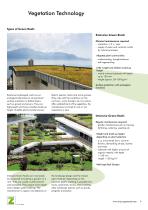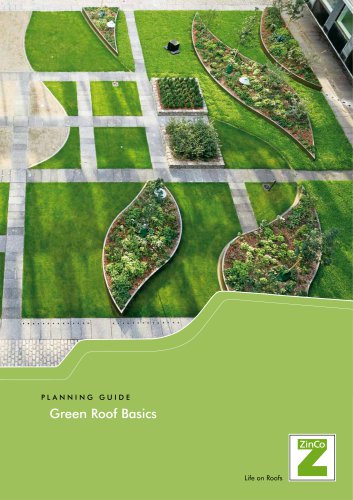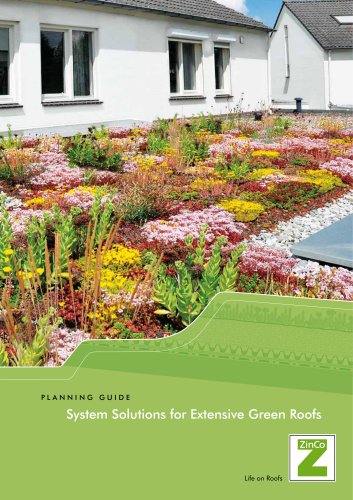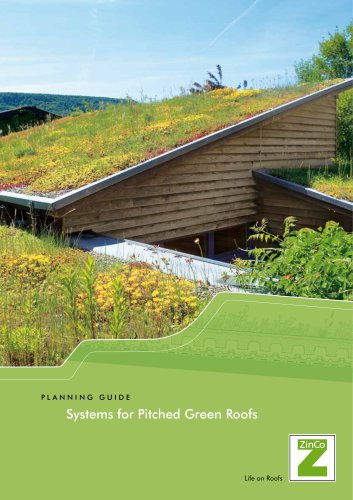 Website:
ZinCo GmbH
Website:
ZinCo GmbH
Group: ZinCo GmbH
Catalog excerpts

PLANNING GUIDE Green Roof Basics
Open the catalog to page 1
Table of Contents Introduction The Roofs of the Future are Green 3 Why Have a Green Roof? 4 Extensive Green Roofs System Build-up "Sedum Carpet" 12 System Build-up "Irrigated Extensive Green Roof" 13 System Build-up 0°-Roof 14 System Build-up "Inverted Green Roof" 15 System Build-up "Stormwater Management" 17 System Build-up "Urban Climate Roof" 18 System Build-up "Pitched Green Roof" 19 System Build-up "Steep Pitched Green Roof" 20 Semi-Intensive Green Roofs System Build-up "Heather with Lavender" 21 Intensive Green Roofs System Build-up "Roof Garden" 22 Irrigation and Substrate Depth 23...
Open the catalog to page 2
Roofs are more than just "functional components" for the protection of the building structure. Roofs give character to individual buildings and entire city districts. Beyond that, roofs are more and more considered as open resource areas. They attract urban planners looking for socially responsible concepts that counteract the loss of natural living space and provide solutions for problems such as stormwater management and urban heat island effect in densely populated cities. Green Roofs are extending the formal language of contemporary architecture and confer a new significance and value...
Open the catalog to page 3
Beyond their attractive visual nature, Green Roofs offer many undisputable benefits, both ecological and economical, provided they are built with the right system. Improve the MicroclimateBind Dust and Toxic Particles Increase Rainwater Retention Improve Noise Protection Green Roofs cool and humidify the surrounding air. Thus they contribute to improving the microclimate in urban centres. This cooling effect significantly increases the performance of air-conditioning systems, reducing carbon emissions. Green Roof vegetation helps to filter out dust and smog particles. Nitrates and other...
Open the catalog to page 4
Roof Technology Roof Shape and Pitch The foundation for a green roof is generally a sealed roof with sufficient loadbearing capacity. Whether it is a typical flat roof with a 2 % minimum pitch slope, a pitched or vaulted roof or a zero pitch roof is of minor importance initially. However, when choosing the green roof build-up factors such as ponding water on the waterproofing membrane or the shear forces and potential erosion which may occur with pitched roofs must be taken into consideration. “Typical flat roof” “Mono pitch roof” “Gable roof” “Butterfly roof” “Saw-tooth roof” “Barrel roof”...
Open the catalog to page 5
Roof Waterproofing Membrane The waterproofing membrane can be made of bituminous, plastic or rubber sheeting or even of a liquid seal. The important thing is that the waterproofing membrane is root-resistant or that it is sufficiently secured by installing a separate root protection system. As regards to sheet thickness, you should not adhere to the minimum thickness required but choose a quality grade that will allow the planned load. Root Barrier Plant roots are a strain on a roof both from a chemical and a physical point of view. Not every waterproofing membrane is capable of permanently...
Open the catalog to page 6
Protection against Wind Suction Particular attention must be paid to increased wind loads on roofs, particularly on top of high and exposed buildings. Roof waterproofing membranes and other accompanying layers can be prevented from being lifted by wind loads by means of gluing, mechanical fixing or by the use of ballast. If a green roof is to function as ballast, it must be installed without delay and must be sufficiently heavy. The wind loads and therefore the required ballast will depend upon the: - location (wind zone) - height and type of building - roof shape and pitch - roof zone...
Open the catalog to page 7
Fire Safety ZinCo green roofs are classified in accordance with German Industrial Standard DIN EN 13501-5 ("Fire classification of construction products and building elements") as BROOF(tl), provided the requirements and advice included below are adhered to. Roofs with an intensive green roof that have to be irrigated and maintained (e. g. roof gardens, underground park decks) and that generally have a deeper substrate level, are to be automatically classified as resistant to sparks and radiant heat. Roofs with an extensive green roof that are not generally irrigated and only have to be...
Open the catalog to page 8
Minimal maintenance required - inspection 1-2 x / year - supply of water and nutrients mostly by natural processes Adapted plant communities - undemanding, drought-tolerant - self-regenerating Little weight and shallow build-up height - mainly mineral substrate with depth up to 120 mm - weight approx. 50-150 kg/m2 Surface protection with ecological functions Extensive landscaped roofs are an ecological alternative to conventional surface protection or ballast layers such as gravel and pavers. They are lightweight and have a shallow build-up height. Suitable plants include various Sedum...
Open the catalog to page 9
Replicating Nature on Roofs When designing and installing a Green Roof it is important to provide a growing environment as close as possible to the plants' natural environment. The most important issue is to compensate for the lack of subsoil. In areas with temperate climates ZinCo systems are able to retain the necessary quantities of water to support the plants, while draining off the excess. The required amount of water is determined by the plant type, the geographical region and the roof itself. Besides building the correct Green Roof system to support the plants, it is very important...
Open the catalog to page 10
Substrate Depth In contrast to the situation with natural ground, there is only a limited amount of root space available on roof areas. Nonetheless, optimum growth conditions must be created for the vegetation in conjunction with the overall system build-up. Water/air balance, which in nature is carried out by powerful soil horizons, is dealt with in a roof situation by substrate layers that are sometimes very shallow. This is addressed by ensuring the appropriate mixture of organic and mineral components. There are two additional specific requirements regarding roof substrates: firstly,...
Open the catalog to page 11All ZinCo GmbH catalogs and technical brochures
-
Green Roof 4.0
16 Pages
-
Solar Energy and Green Roof
8 Pages
-
NATURE LINE
4 Pages
-
Product List
50 Pages
-
Zinco Product List
50 Pages
-
Corporate Brochure
24 Pages
-
Green Roof 4.0
16 Pages
-
Solar Energy and Green Roofs
8 Pages
-
Systems for Pitched Green Roofs
18 Pages
-
Urban Rooftop Farming
4 Pages
-
Natureline
4 Pages


















